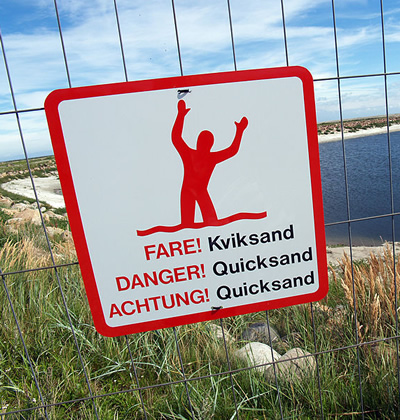
- Quicksand warning sign in Denmark - photo by Matthew Bargo
The image of someone casually walking across a tract of sand and suddenly finding themselves sinking deep into the Earth is something that many of us have witnessed on film or TV. As the protagonist’s body begins to disappear and they scream for help, we realize that they have unwittingly fallen into quicksand.
What is quicksand? Dramatic portrayals of quicksand victims make it seem as though quicksand is a living entity that consciously grabs unwary travelers and attempts to carry them to their doom within the Earth’s bowels. In fact, quicksand is simply sand or soil that has been shaken up and saturated with water, usually from an underground spring. Quicksand can also form when the tide moves up onto a beach or when an earthquake shakes up underground water and sand.
How to Escape Quicksand
If you leave quicksand alone, it will thicken again. Some types of quicksand are more watery than others. Quicksand with a lower water content will become very viscous when it thickens. Trying to pull your leg out of it would be like trying to pull your leg out of a giant vat of molasses or a tub of wet concrete.
Although people are often advised not to move around in quicksand, with this type of quicksand, moving your legs around to loosen up the sand can be a good idea. When you move your legs, you agitate the sand and cause water to flow between the grains, so that the quicksand becomes thinner and flows more easily. This can make it easier for someone to pull you out.
With the more watery type of quicksand, it is better to lie on your back and, using slow movements so you do not move the sand about too much, try to paddle to safety.
Can you drown in quicksand?
Quicksand behaves like any other liquid in that objects that are denser than the liquid will sink and objects that are less dense will float. Humans can float on water. Quicksand is even denser than water, so we will always float on it. You might sink into quicksand as far as your waist, but it is impossible for your whole body to sink. So much for the media image of someone sinking progressively lower into quicksand until nothing but a hat is visible above the sand.
Because quicksand only behaves like a liquid when it is agitated, objects that are even denser than quicksand can remain safely on top of it until something causes the quicksand to move. These objects will then sink.
Although you will not sink to the bottom of a pool of quicksand, being trapped in quicksand can be deadly.
You could drown in quicksand if you somehow got your head underneath the sand. Similar drownings occur in the Dead Sea, which, because of its high salt content, is also much denser than water. Humans can’t sink in the Dead Sea either, but they can drown if they turn face down and their faces become submerged so they can’t breathe.
If you were trapped in quicksand near an ocean, you could drown when the tide came in.
You could also die of thirst, exhaustion or exposure to the elements if you were trapped for too long.
Movies and TV usually do not portray quicksand very realistically. Can you provide any examples where TV or film quicksand behaves as it does in real life? Or have you ever encountered quicksand yourself? Let us know in your Comments.